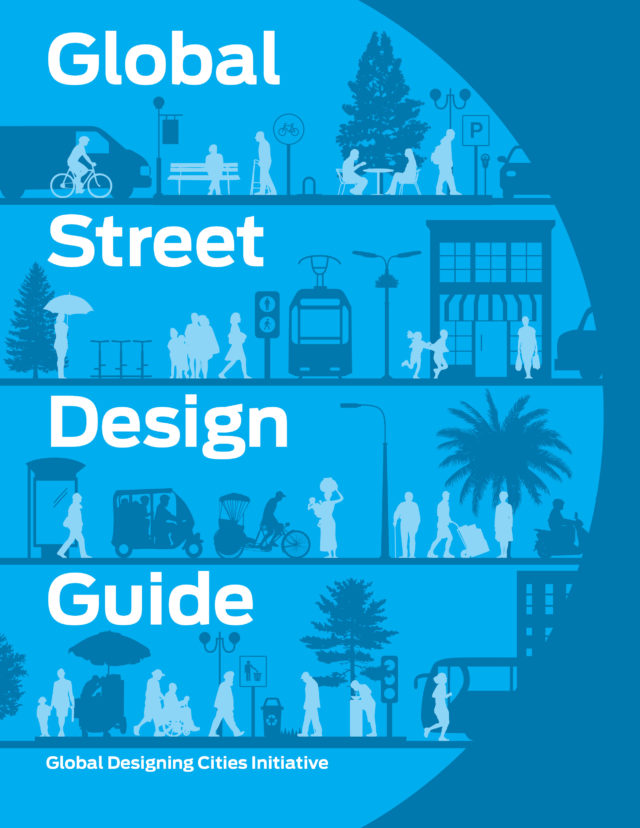New Guide is the First-Ever Worldwide Standard for Designing Safe, Sustainable City Streets
 For Immediate Release:
For Immediate Release:
October 13, 2016
Press Contact:
Abhimanyu Prakash
[email protected] | 917.893.1325
See sample pages from the Guide >
Download sample print-ready images (16 MB ZIP)>
The National Association of City Transportation Officials (NACTO) and the Global Designing Cities Initiative today unveiled the Global Street Design Guide, the first-ever worldwide standard for redesigning city streets to prioritize safety, pedestrians, transit and sustainable mobility for an urban century.
Street design is one of the single most powerful instruments available to city planners to combat traffic danger, a persistent global health crisis responsible for 1.25 million deaths annually. Street design is also the key to resolving larger issues of cities’ economic vitality, livability, and physical and social mobility. The Guide comes as urban populations increase around the world and amid a sea change in the number of cities designing, testing and implementing street transformations.
“This guide is drawn from life and from the real-world designs that are transforming streets from Auckland to São Paulo to Addis Ababa,” said Janette Sadik-Khan, NACTO Chair and Principal at Bloomberg Associates. “The tested and proven designs in these pages can be adapted to city streets around the world to support local economies and make them safer for everyone, no matter how they get around. It is no longer a question of engineering or innovation but of the imagination and will needed to update city streets for a new age.”
The Global Street Design Guide sets a new global baseline for designing urban streets. Recognizing that cities are places for people, the guide shifts the parameters of designing urban streets from the typical point of view of automobile movement and safety, to include access, safety, and mobility for all users, environmental quality, economic benefit, enhancement of place, public health, and overall quality of life.
Created with the input of 72 cities in 42 countries, this new manual presents 21 street typologies and 50 unique street and intersection transformations applicable worldwide. With over 40 case studies, the Guide shows in actionable terms how to redesign streets to put people first. From moving more people with transit lanes, to dedicating space for vibrant economic activity like street vendors, this new global toolkit is applicable to a variety of contexts worldwide.
The Guide builds on NACTO’s successful Urban Street Design Guide, Urban Bikeway Design Guide, and Transit Street Design Guide, expanding from a North American context to address a variety of street typologies and design elements found around the world.
Advance praise for the Global Street Design Guide:
“Smart street design improves lives in so many ways, from reducing emissions that cause harmful air pollution and drive climate change, to making streets safer and helping local businesses,” said Michael R. Bloomberg, Founder of Bloomberg Philanthropies, and Former Mayor of the City of New York. “The Global Street Design Guide is a powerful resource that can help cities around the world become safer and stronger.”
“For more than a century, street life was what grew through the cracks in pavement—a liveliness that thrived despite the asphalt and traffic,” said Jan Gehl, Urbanist, Architect, and Author of Cities for People. “The Global Street Design Guide starts from an opposite principle, that we can’t wait for streets to produce human outliers that survive against the odds, but that we must instead design them to make active, engaging street life possible.”
“Streets are the foundation of a city’s entire social structure—getting around, working, living, shopping, and playing,” said Enrique Peñalosa, Mayor of Bogotá. “With the guide, cities have, for the first time, a universal resource for creating cities that operate for everyone who uses them.”
The Global Street Design Guide is available for purchase from Island Press (islandpress.org). Development of the Guide was supported by Bloomberg Philanthropies, as part of Bloomberg Philanthropies’ Initiative for Global Road Safety.
####
About the Global Designing Cities Initiative
The Global Designing Cities Initiative (GDCI) focuses on the critical role of streets within urban environments around the world. In partnership with the National Association of City Transportation Officials (NACTO) and working with a Global Expert Network, the GDCI is committed to sharing industry best practices, facilitating peer-to-peer mentoring and fostering regular communication. The GDCI facilitates the exchange of ideas that help a variety of stakeholders shape streets to promote public health and safety, quality of life, multi-modal mobility, economic development, environmental sustainability and equity. GDCI believes that by working together, cities can save time and money, share lessons learned, scale up best practice implementation and more effectively achieve their policy goals and objectives.